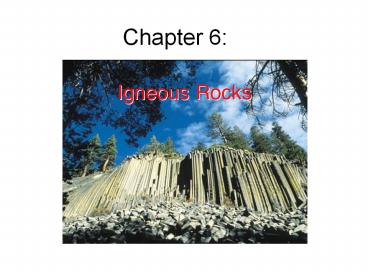Chapter 6: Igneous Rocks - PowerPoint PPT Presentation
1 / 19
Title:
Chapter 6: Igneous Rocks
Description:
Title: Chapter 6: Igneous Rocks Author: Guest Last modified by: Instructor Created Date: 5/4/2006 4:37:49 PM Document presentation format: On-screen Show (4:3) – PowerPoint PPT presentation
Number of Views:128
Avg rating:3.0/5.0
Title: Chapter 6: Igneous Rocks
1
Chapter 6
2
What are igneous rocks?
- Igneous rocks gets its name from the Latin word
for fire, because it is formed from hot molten
rock (magma) inside the Earth. When the molten
rock solidifies, it forms solid igneous rock. - The way the magma cools determines the kind of
igneous rock that is formed. - Magma is molten rock, while lava is magma on the
Earths surface. - Igneous rocks may be either extrusive if they
form at the surface (ex. basalt) or intrusive if
magma solidifies underground (ex. granite).
Watch Video
3
From Minerals to Rocks
4
Igneous Rock Textures
- Texture refers to a rocks appearance with
respect to the size, shape and arrangement of its
grains. - Extrusive rocks are typically fine-grained
(grains smaller than 1mm). The grains are small
because the magma cooled rapidly at the surface,
and large crystals did not have time to form.
Some intrusive rocks are fine grained, but these
would have formed near the surface in cold
rock.
Extrusive rock called obsidian. This is a
glass-like rock that forms at the surface
5
Igneous Rock Textures
- Intrusive rocks usually form at considerable
depth (more than a few km) and are called
plutonic rocks (after Pluto, the Roman god of the
underworld). - Intrusive rocks are typically coarse-grained
(bigger than 1mm) because of the slow cooling and
solidification of magma
6
How are igneous rocks classified?
- Igneous rocks names are based on texture
(basically grain-size) and mineral composition. - So, each type of igneous rock will have
- 1. a specific combination of minerals.
- 2. coarse or fine grains.
- Plutonic rocks are easier to identify because of
the larger crystals.
7
Common Igneous RocksGroup 1
Granite Rhyolite
Formed inside Earth Formed at surface
Coarse-grained Fine-grained
Quartz crystals visible Crystals too small
Feldspars Feldspars
8
Common Igneous RocksGroup 2
Diorite Andesite
Formed inside Earth Formed at surface
Coarse-grained Fine-grained
No quartz Crystals too small to see
Feldspars 30-50 ferromagnesian minerals Feldspars 30-50 ferromagnesian minerals
9
Common Igneous RocksGroup 3
Gabbro Basalt
Formed inside Earth Formed at surface
Coarse-grained Fine-grained
Mostly ferromagnesian minerals Mostly ferromagnesian minerals
Some feldspars Some feldspars
10
Identification of Igneous Rocks
11
Occurrences of Igneous Rock
Occurrence
12
What happens when magma cools underground?
- Cooling magma may form intrusive structures, or
bodies of magma that crystallize/harden after
flooding surrounding rock layers
13
Examples of Intrusive Structures
- 1. Volcanic neck (magma is solidified in the neck
of a volcano) - 2. Dike Sills (magma solidifies into a wall
after being squeezed through two rock layers) - Ex. Ship Rock in New Mexico, USA
14
Shiprock, New Mexico
Volcanic neck
Dike
Shiprock Video (420 mark)
15
Dikes Sills
16
Examples of Intrusive Structures (contd)
- Plutons are blobs of magma that crystallize
within the crust. If these plutons make it to
the surface, large areas of rock (usually
granite) form huge outcrops of rock at the
surface. Batholiths are areas of plutons greater
than 100km2. Batholiths are present in the Sierra
Nevada Mountains of California and in the
Appalachian Mountains
17
Halifax Pluton, South Mountain Batholith, Nova
Scotia
18
Batholith Formation
19
Examples of Extrusive Structures
- The most obvious structures made of extrusive
igneous rock (or igneous rock at the surface)
are































